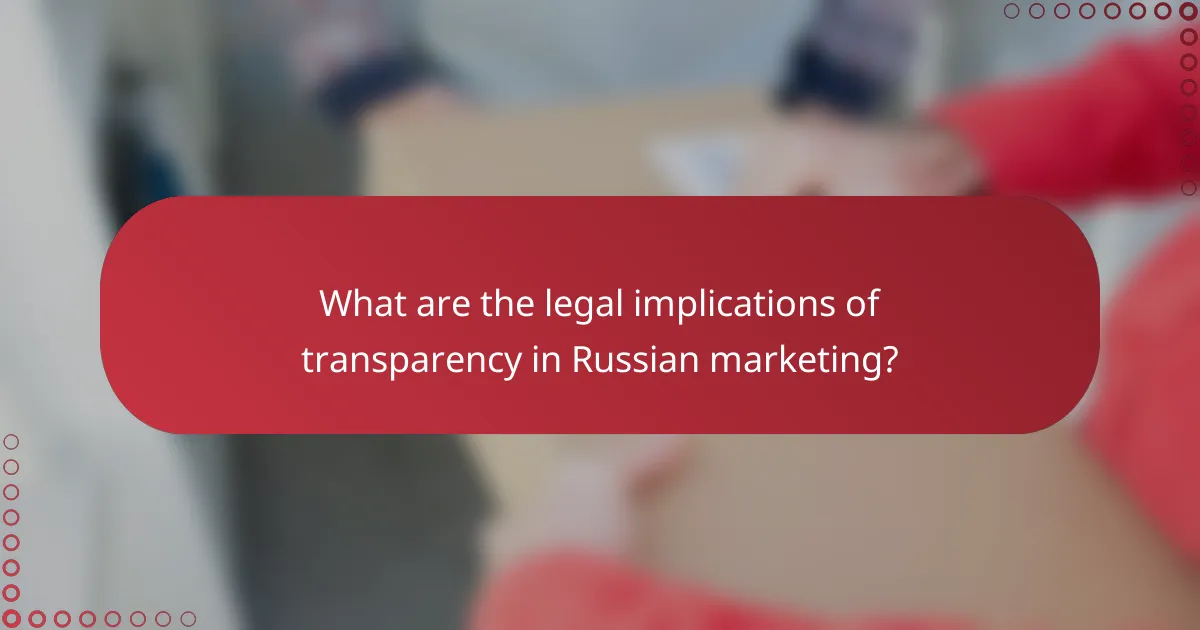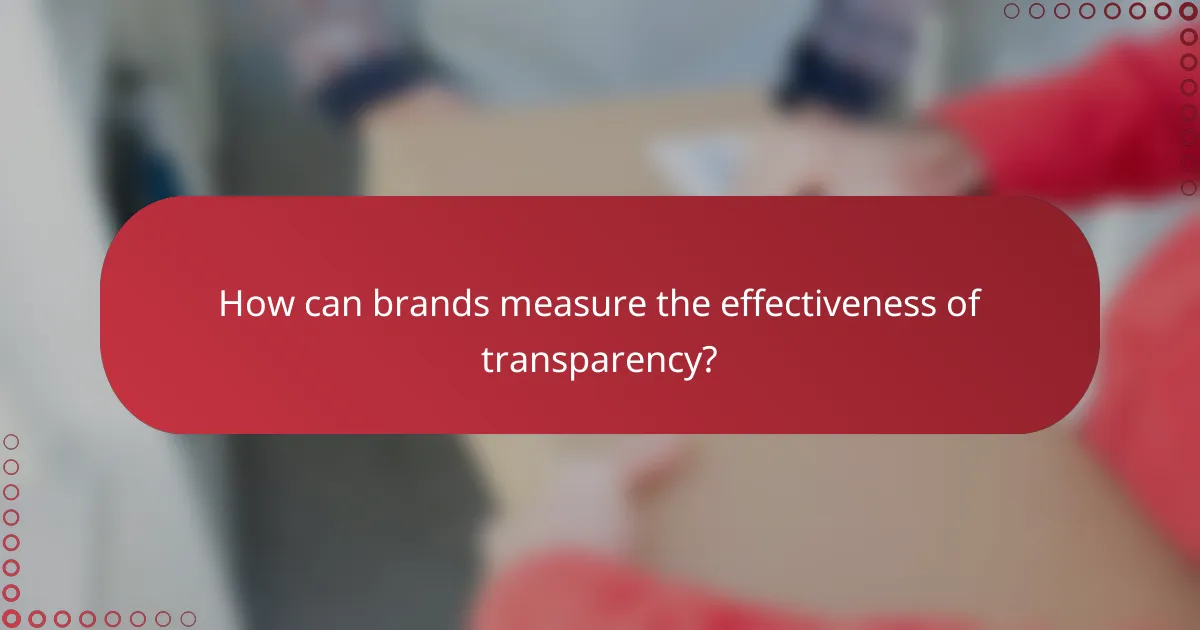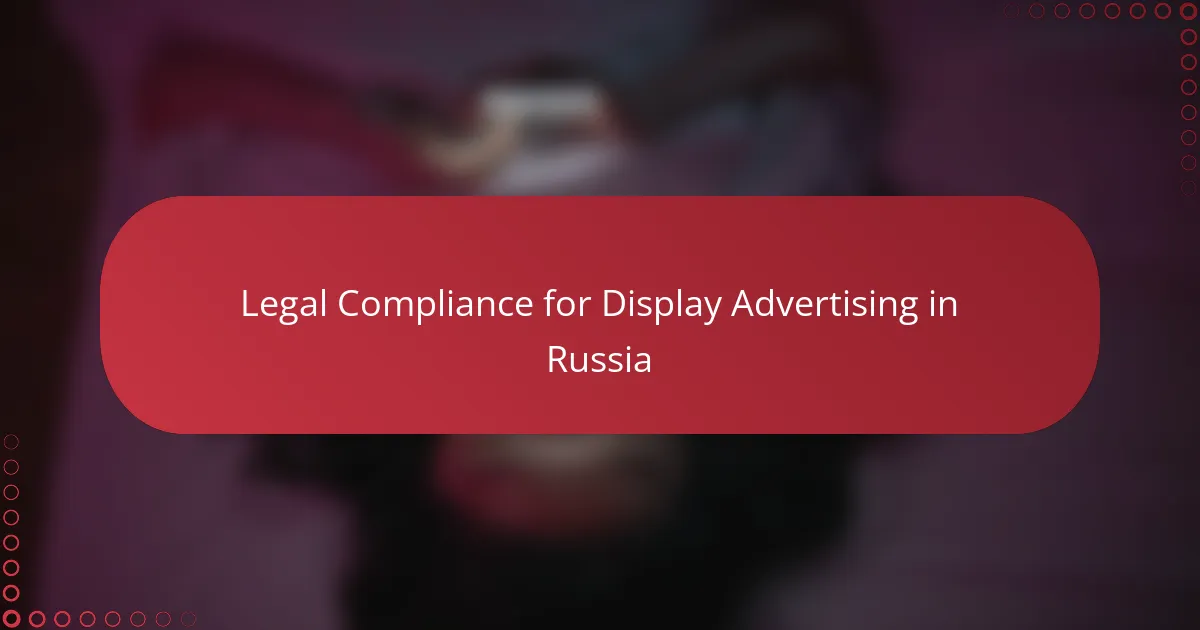Building trust through transparency in Russian marketing funnels is essential for enhancing customer relationships and boosting sales. By openly sharing information about products, pricing, and business practices, companies can create a more engaging and trustworthy environment for consumers. Effective strategies include clear communication of data usage and authentic testimonials, which help demystify the purchasing process and foster a sense of reliability.

How can transparency enhance Russian marketing funnels?
Transparency in Russian marketing funnels can significantly improve customer relationships and drive sales. By openly sharing information about products, pricing, and business practices, companies can foster trust and encourage consumer engagement.
Builds consumer trust
Transparency builds consumer trust by providing clear and honest information about products and services. When customers feel informed, they are more likely to believe in the integrity of a brand. For instance, sharing detailed product descriptions, sourcing information, and pricing breakdowns can help demystify the purchasing process.
Additionally, companies that openly address customer concerns and feedback demonstrate accountability. This approach can lead to a positive reputation, as consumers appreciate brands that prioritize honesty and communication.
Improves conversion rates
Improving transparency can lead to higher conversion rates in Russian marketing funnels. When potential customers have access to comprehensive information, they are more likely to make informed purchasing decisions. For example, displaying customer reviews and testimonials can provide social proof, encouraging hesitant buyers to complete their transactions.
Moreover, clear pricing policies and straightforward return processes can reduce friction in the buying journey. By eliminating hidden fees and complicated terms, businesses can create a smoother experience that drives sales.
Encourages brand loyalty
Transparency fosters brand loyalty by creating a sense of community and connection between consumers and brands. When customers feel they can trust a company, they are more likely to return for future purchases. Regularly communicating updates, changes, and company values can reinforce this bond.
Furthermore, loyalty programs that reward transparency, such as offering discounts for sharing feedback or referrals, can enhance customer retention. Engaging customers in this way not only builds loyalty but also encourages them to advocate for the brand within their networks.

What are effective transparency strategies in Russian marketing?
Effective transparency strategies in Russian marketing include clear communication of data usage, authentic customer testimonials, and open pricing structures. These approaches help build trust with consumers by ensuring they understand how their information is used, what to expect from products, and the costs involved.
Clear communication of data usage
Clearly communicating how customer data is used is crucial for building trust in Russian marketing. Businesses should inform customers about the types of data collected, the purpose of collection, and how it will be protected. This can be done through straightforward privacy policies and regular updates.
For example, a company might explain that user data is utilized to enhance service personalization or improve product offerings. Providing customers with options to opt-in or opt-out of data collection can further enhance transparency.
Authentic customer testimonials
Authentic customer testimonials serve as powerful tools in establishing credibility. In the Russian market, potential buyers often seek reassurance from the experiences of others before making a purchase. Displaying genuine reviews and ratings can significantly influence consumer decisions.
To ensure authenticity, businesses should encourage customers to leave feedback on various platforms, including social media and review sites. Highlighting both positive and constructive feedback can demonstrate a commitment to transparency and customer satisfaction.
Open pricing structures
Open pricing structures are essential for fostering trust in Russian marketing. Customers appreciate knowing the full cost of products or services upfront, without hidden fees or unexpected charges. This clarity can lead to higher conversion rates and customer loyalty.
Businesses should provide detailed pricing information on their websites, including any additional costs such as shipping or taxes. Offering clear comparisons between different pricing tiers can help customers make informed decisions and feel more confident in their purchases.

How do cultural factors influence transparency in Russia?
Cultural factors significantly shape the expectations and practices of transparency in Russian marketing. Trust is often built through personal connections and a deep understanding of historical contexts that have influenced consumer behavior.
Importance of personal relationships
In Russia, personal relationships play a crucial role in establishing trust between businesses and consumers. Marketers should focus on building rapport through direct communication and personalized interactions, as these can enhance credibility and foster loyalty.
For example, brands that engage with customers on social media or through local events often see higher levels of trust and transparency. This approach encourages consumers to feel valued and understood, which is essential in the Russian market.
Historical context of trust issues
The historical backdrop of Russia, marked by periods of political and economic instability, has led to widespread skepticism towards institutions and businesses. This context necessitates a careful approach to transparency in marketing strategies.
Marketers should acknowledge this history by being open about their business practices and values. Transparency in pricing, product sourcing, and customer service can help mitigate distrust and build a more reliable brand image.

What tools can improve transparency in marketing funnels?
Several tools can enhance transparency in marketing funnels, allowing businesses to track customer behavior and optimize their strategies. Key tools include Google Analytics for data tracking and HubSpot for managing customer relationships.
Google Analytics for data tracking
Google Analytics is a powerful tool that provides insights into user behavior on your website. It tracks metrics such as page views, bounce rates, and conversion rates, helping marketers understand how users interact with their funnels.
To maximize its effectiveness, set up goals that align with your marketing objectives. For instance, if your goal is to increase newsletter sign-ups, create a specific goal in Google Analytics to monitor this conversion. Regularly review the data to identify trends and areas for improvement.
HubSpot for customer relationship management
HubSpot is a comprehensive customer relationship management (CRM) platform that enhances transparency by centralizing customer interactions and data. It allows marketers to track leads through the sales funnel, from initial contact to final conversion.
Utilize HubSpot’s reporting features to analyze customer engagement and identify which marketing strategies are most effective. By segmenting your audience based on behavior and preferences, you can tailor your communications and improve overall funnel performance.

What are the legal implications of transparency in Russian marketing?
Transparency in Russian marketing carries significant legal implications, primarily related to consumer rights and data protection. Marketers must navigate various regulations to ensure they are not only compliant but also building trust with their audience.
Compliance with data protection laws
In Russia, compliance with data protection laws is crucial for maintaining transparency in marketing practices. The Federal Law on Personal Data requires businesses to obtain explicit consent from individuals before processing their personal information. This means that marketers must clearly inform consumers about how their data will be used and ensure that it is securely stored.
To comply, businesses should implement transparent data handling policies and regularly audit their practices. For example, providing clear privacy notices and easy opt-out options can enhance consumer trust and reduce the risk of legal repercussions.
Impact of the Federal Law on Advertising
The Federal Law on Advertising imposes specific requirements that affect how transparency is perceived in marketing communications. Advertisers must ensure that their claims are truthful and not misleading, which necessitates clear disclosures about the nature of products and services. This law aims to protect consumers from deceptive practices.
Marketers should focus on providing accurate information and avoid exaggerating benefits. For instance, using straightforward language and avoiding ambiguous terms can help meet legal standards while fostering trust with potential customers. Regular training on compliance for marketing teams is also advisable to stay updated on any changes in legislation.

How can brands measure the effectiveness of transparency?
Brands can measure the effectiveness of transparency by evaluating customer perceptions and engagement levels. This involves gathering direct feedback and analyzing key performance indicators that reflect how transparent practices influence customer trust and loyalty.
Customer feedback surveys
Customer feedback surveys are a direct way to gauge perceptions of transparency. Brands can design surveys that ask specific questions about customers’ views on the clarity of information provided, such as pricing, product details, and company policies.
To ensure meaningful insights, include a mix of quantitative questions (like rating scales) and qualitative questions (open-ended responses). Aim for a response rate of at least 20-30% to gather a representative sample of opinions.
Analytics on engagement metrics
Engagement metrics provide quantitative data on how customers interact with transparent content. Key metrics to track include website bounce rates, time spent on pages, and click-through rates on transparency-related communications, such as FAQs or policy updates.
For effective analysis, compare these metrics before and after implementing transparency initiatives. A notable increase in engagement can indicate that customers appreciate and trust the information being shared.



